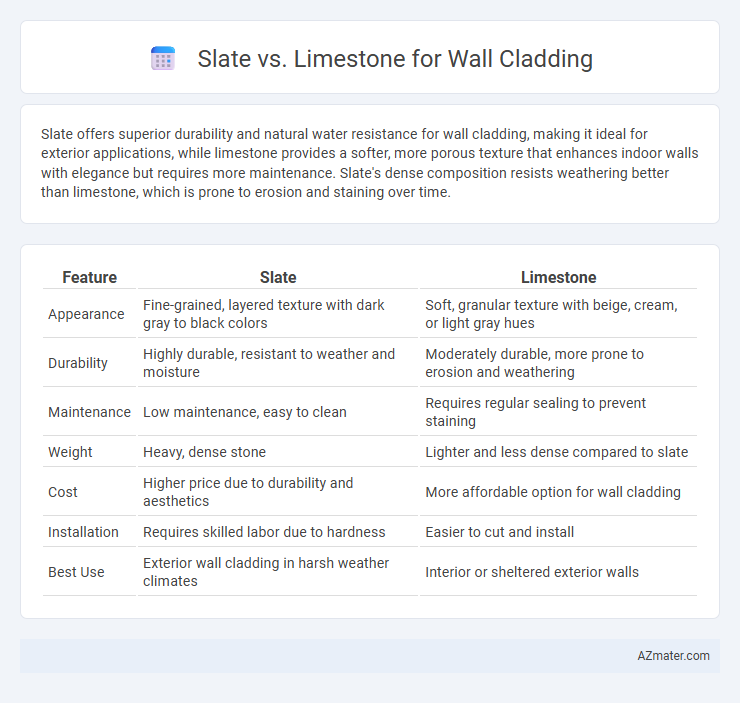Slate offers superior durability and natural water resistance for wall cladding, making it ideal for exterior applications, while limestone provides a softer, more porous texture that enhances indoor walls with elegance but requires more maintenance. Slate's dense composition resists weathering better than limestone, which is prone to erosion and staining over time.
Table of Comparison
| Feature | Slate | Limestone |
|---|---|---|
| Appearance | Fine-grained, layered texture with dark gray to black colors | Soft, granular texture with beige, cream, or light gray hues |
| Durability | Highly durable, resistant to weather and moisture | Moderately durable, more prone to erosion and weathering |
| Maintenance | Low maintenance, easy to clean | Requires regular sealing to prevent staining |
| Weight | Heavy, dense stone | Lighter and less dense compared to slate |
| Cost | Higher price due to durability and aesthetics | More affordable option for wall cladding |
| Installation | Requires skilled labor due to hardness | Easier to cut and install |
| Best Use | Exterior wall cladding in harsh weather climates | Interior or sheltered exterior walls |
Introduction to Wall Cladding Materials
Wall cladding materials like slate and limestone are popular choices for enhancing building exteriors due to their durability and aesthetic appeal. Slate offers natural cleavage, creating a textured, dark-hued finish ideal for modern and rustic designs. Limestone provides a softer, warm-toned surface with excellent insulation properties, often preferred in traditional and Mediterranean architecture.
Slate and Limestone: Material Overview
Slate is a durable, fine-grained metamorphic rock known for its natural cleft surface, making it ideal for wall cladding due to its dynamic texture and water resistance. Limestone, a sedimentary rock primarily composed of calcium carbonate, offers a softer, more uniform appearance with excellent workability but requires sealing to enhance its durability for exterior applications. Both materials provide unique aesthetic and functional benefits, with slate favored for rugged, weather-resistant installations and limestone chosen for elegant, classic finishes.
Aesthetic Appeal: Slate vs Limestone
Slate offers a rich, textured surface with natural color variations ranging from deep grays to vibrant blues, lending a dramatic and elegant aesthetic to wall cladding. Limestone provides a softer, more uniform appearance, typically in warm beige or cream tones, creating a classic and timeless look. Both materials enhance architectural beauty, but slate's rugged texture contrasts with limestone's smooth, refined finish.
Durability and Longevity Comparison
Slate offers exceptional durability for wall cladding due to its dense, fine-grained structure, making it highly resistant to weathering, chipping, and cracking over time. Limestone, while also durable, is a softer sedimentary rock that may show signs of erosion or surface wear faster in harsh environmental conditions. Slate's superior hardness and low porosity contribute to its longer lifespan and minimal maintenance requirements compared to limestone.
Weather Resistance and Maintenance Needs
Slate offers superior weather resistance for wall cladding due to its dense, non-porous structure that withstands moisture, freeze-thaw cycles, and UV exposure with minimal degradation. Limestone, being more porous and softer, tends to absorb water and is prone to weathering, requiring regular sealing to maintain durability. Maintenance of slate walls is minimal, involving occasional cleaning, whereas limestone demands frequent inspections and treatments to prevent erosion and staining.
Installation Process and Challenges
Slate wall cladding requires precise cutting due to its natural cleft surface, demanding skilled labor and specialized tools for installation to ensure proper alignment and durability. Limestone, being softer and more uniform, is easier to shape and install but necessitates careful handling to prevent chipping and surface damage. Both materials require waterproofing measures and secure anchoring systems to address weather resistance and structural stability challenges.
Cost Analysis: Slate vs Limestone
Slate wall cladding typically costs between $15 and $25 per square foot, reflecting its durable nature and aesthetic appeal, whereas limestone ranges from $20 to $30 per square foot due to its softer texture and higher maintenance needs. Installation costs for both materials vary but tend to be higher for limestone because of its fragility and the specialized handling required. Overall, slate offers a cost-effective solution with long-term durability, while limestone demands a higher initial investment and potential ongoing expenses.
Environmental Impact and Sustainability
Slate offers a lower environmental impact for wall cladding due to its natural durability and minimal processing requirements, resulting in reduced energy consumption and lower carbon emissions. Limestone, while abundant and widely used, often requires more intensive quarrying and processing, which can increase environmental degradation and energy use. Both materials are recyclable and long-lasting, but slate's superior weather resistance and lower maintenance needs enhance its sustainability profile over limestone.
Applications and Design Versatility
Slate offers exceptional durability and water resistance, making it ideal for exterior wall cladding in regions prone to moisture and temperature fluctuations. Limestone provides a softer, more natural aesthetic with a range of warm tones and textures, enhancing interior and exterior walls where design versatility is key. Both materials support various architectural styles, but limestone's workability allows for intricate carvings and custom shapes, while slate excels in creating sleek, modern facades with minimal maintenance.
Choosing the Best Stone for Your Wall Cladding
Slate offers a dense, fine-grained texture with excellent water resistance, making it ideal for exterior wall cladding exposed to harsh weather conditions. Limestone provides a softer, porous surface with warm, natural tones that enhance aesthetic appeal but requires sealing to prevent moisture damage and staining. Evaluating factors like durability, maintenance, climate compatibility, and desired visual impact will help determine the best stone for your specific wall cladding project.

Infographic: Slate vs Limestone for Wall Cladding
 azmater.com
azmater.com